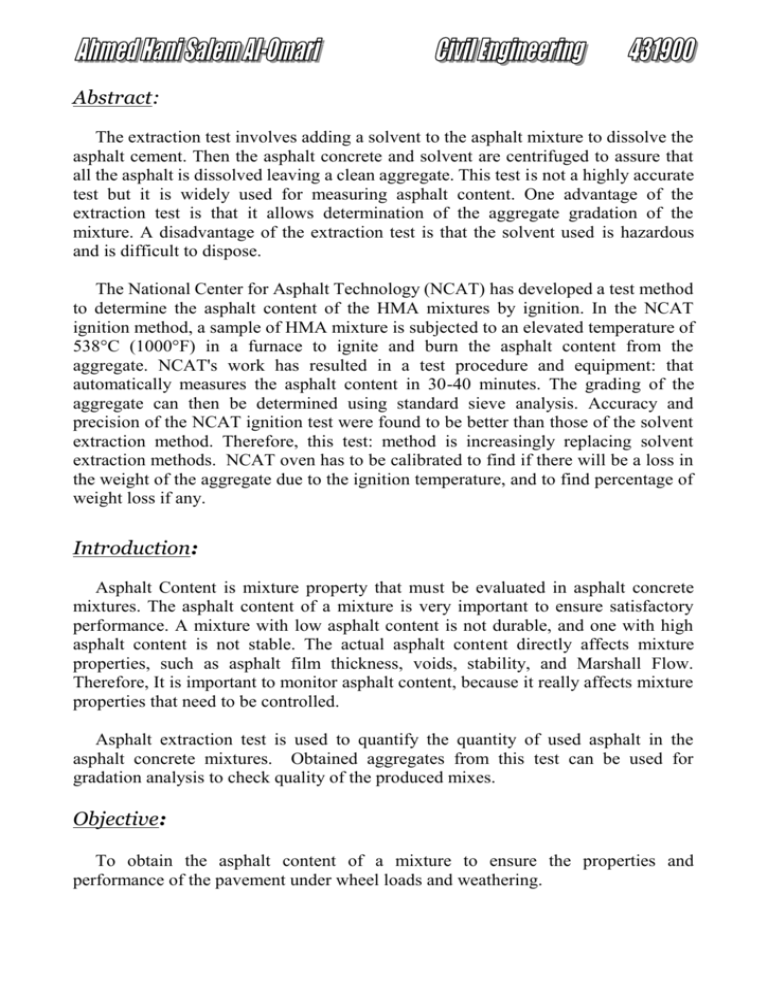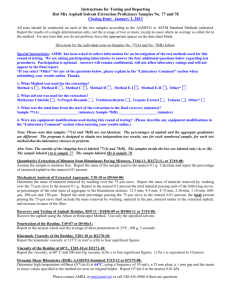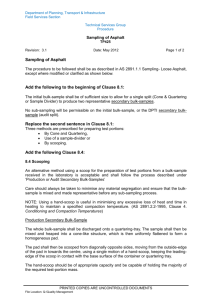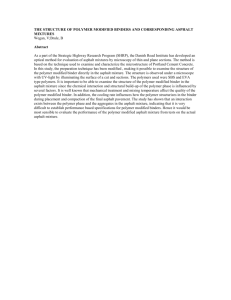ASPHALT EXTRACTION - Icivil-Hu
advertisement

Abstract: The extraction test involves adding a solvent to the asphalt mixture to dissolve the asphalt cement. Then the asphalt concrete and solvent are centrifuged to assure that all the asphalt is dissolved leaving a clean aggregate. This test is not a highly accurate test but it is widely used for measuring asphalt content. One advantage of the extraction test is that it allows determination of the aggregate gradation of the mixture. A disadvantage of the extraction test is that the solvent used is hazardous and is difficult to dispose. The National Center for Asphalt Technology (NCAT) has developed a test method to determine the asphalt content of the HMA mixtures by ignition. In the NCAT ignition method, a sample of HMA mixture is subjected to an elevated temperature of 538°C (1000°F) in a furnace to ignite and burn the asphalt content from the aggregate. NCAT's work has resulted in a test procedure and equipment: that automatically measures the asphalt content in 30-40 minutes. The grading of the aggregate can then be determined using standard sieve analysis. Accuracy and precision of the NCAT ignition test were found to be better than those of the solvent extraction method. Therefore, this test: method is increasingly replacing solvent extraction methods. NCAT oven has to be calibrated to find if there will be a loss in the weight of the aggregate due to the ignition temperature, and to find percentage of weight loss if any. Introduction: Asphalt Content is mixture property that must be evaluated in asphalt concrete mixtures. The asphalt content of a mixture is very important to ensure satisfactory performance. A mixture with low asphalt content is not durable, and one with high asphalt content is not stable. The actual asphalt content directly affects mixture properties, such as asphalt film thickness, voids, stability, and Marshall Flow. Therefore, It is important to monitor asphalt content, because it really affects mixture properties that need to be controlled. Asphalt extraction test is used to quantify the quantity of used asphalt in the asphalt concrete mixtures. Obtained aggregates from this test can be used for gradation analysis to check quality of the produced mixes. Objective: To obtain the asphalt content of a mixture to ensure the properties and performance of the pavement under wheel loads and weathering. Equipments & Apparatus: 1- Oven, capable of maintaining the temperature at 110°C. 2- Pan 3- Balance. 4- Hot Plate, electric, 700-W. 5- Small-Mouth Graduate, 1000 or 2000-mL capacity. 6- Optional small-mouth graduate, 100-mL capacity. 7- Ignition Dish, 125-mL capacity. 8- Desiccators. 9- Analytical Balance. 10-Container for catching the solvent. 11-Filter Rings. 12-Solvent. Figure 16.1: NCAT ignition oven Figure 16.2: Centrifuge Extraction Apparatus Procedure: - The extraction test will be performed using centrifuge and NCAT extraction methods. a) Centrifuge Extraction Procedure: The recommended test procedure for the centrifuge extraction test is as follows: 1- If the mixture is not sufficiently soft to separate with a spatula or trowel, place it in a large, flat pan and warm to 110°C, only until it can be handled or mixed. 2- Dry the empty centrifuge bowl with the filter paper to a constant weight, and record this weight in the data sheet. 3- Dry the test sample at 110°C to remove the moisture from it. 4- Place a sample (650-2500 g) of the asphalt concrete mixture into the bowl of the centrifuge apparatus. Record this weight as W1. 5- Cover the test sample with trichloroethylene, trichloroethane, methylene chloride, or diesel and allow sufficient time for the solvent to disintegrate the test portion (not over 1 h). 6- Fit the filter paper on the bowl, clamp the cover on the bowl tightly and place a beaker under the drain to collect the extract. 7- Start the centrifuge revolving slowly and gradually increase the speed to a maximum of 3600 rpm or until solvent ceases to flow from the drain pipe. 8- Stop the machine, add 200 ml of the solvent, and repeat the centrifuge procedure. 9- Repeat Step # 8 sufficient times (not less than three) so that the extract has a light color. 10Collect the extract and the washings in a suitable graduated cylinder. 11Dry the bowl with the filter paper to a constant weight in an oven at 110 + 5°C. 12Weight the dried aggregate and the filter paper. Designate the weight of the aggregate with the increase in the weight of the filter paper as W2. 13Determine the amount of mineral matter in the extract using the following procedure: a. Record the volume of the total extract (from Step 8) in the graduated cylinder. Designate this volume as V1. b. Agitate the extract thoroughly and immediately take a representative sample (between 300-500ml) from the extract. Designate this volume as V2. c. Place the selected extract into a previously tared and calibrated flask. d. Place the flask in a controlled-temperature bath controlled to ±0.1°C, and allow to come to the temperature at which the flask was calibrated. e. Fill the flask with solvent which has been kept at the same temperature. Bring the level of the liquid in the flask up to the neck, insert the stopper, making sure the liquid overflows the capillary, and remove from the bath. f. Wipe the flask dry, determine the mass to the nearest 0.1 g, and record this mass as the mass of flask plus extract. b) NCAT Extraction Procedure: 1- If the mixture is not sufficiently soft to separate with a spatula or trowel, place it in a large, flat pan and warm to 110°C) only until it can be handled or mixed. 2- Split or quarter the material until the mass of material (around 3 kg) required for test is obtained. 3- Dry the test sample at 110°C to remove the moisture from it. 4- Weight the sample and record this weight as, W4. 5- Spread the sample on the ignition tray. 6- Leave the sample inside the oven for 30-40 min. 7- At the end of the ignition time, take the sample out of the oven and leave it to cool down. 8- Take the weight of the ignited sample and record it as W5. 9- Calculate the bitumen content as: Bitumen Content, AC% = ( W 4 W 5 ) *100 W5 (4) 9- Sieve analysis can be performed on the obtained sample. Data & Analysis: Weight of test sample ( Kg ) Weight of ignited sample ( Kg ) Bitumen content ( AC% ) Table 1 : Results for NACT procedure. Calculation: - Bitumen Content, AC % = ( W (dry ) W (ignited ) ) *100 W (ignited ) = Discussion & Conclusion: This test is not a highly accurate test but it is widely used for measuring asphalt content. This test is used to determine the asphalt content in the mix which gives us important properties of the tested specimen and to predict the performance of the pavement under the wheel load and weathering. A disadvantage of the extraction test is that the solvent used is hazardous and is difficult to dispose. This test is also gives us a practical process to check the quality of the mix by make a sieve analysis on the obtained aggregate. As noted from the test the centrifuge extraction method needs more time than the NCAT procedure, the NCAT procedure is also more accurate than the centrifuge method.







